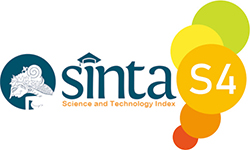EFEKTIFITAS METODE KOLB’S LEARNING DALAM PEMBELAJARAN MATA KULIAH KEWIRAUSAHAAN DI INTERNATIONAL BUSINESS ADMINISTRATION PROGRAM FAKULTAS EKONOMI DAN BISNIS UNIVERSITAS SAM RATULANGI
DOI:
https://doi.org/10.35794/jmbi.v6i2.26168Abstract
This research will contribute to the development of knowledge and application of theory to lecturers, students, and the university, as well as the community in terms of: The research provides the lecturer's benchmark on how or methods to Raises students ' interest in learning entrepreneurship courses, this research can help students to study entrepreneurship courses are more effective and could lead to students ' interest for entrepreneurial, this research can Provide an applied curriculum standard to the university which is titled on a Competency-based lecture system. The results of two-lane equation models in this study show that overall, variables diverging (X1), assimilating (X2), converging (X3) and accommodating (X4) have a significant influence on the effectiveness of learning from The Applied Entrepreneurship Curriculum (Y), thus influencing the student's desire to start his own businessKeywords: Kolb’s Learning Method, Entrepreneuship
References
Alas, R., Ãœbius, U., Lorents, P., & Matsak, E. (2017). Corporate Social Responsibility In European And Asian Countries. Jurnal Manajemen Bisnis Dan Inovasi (JMBI) UNSRAT Vol. 4 No. 1
Aluy, C. A., Tulung, Joy Elly, & Tasik, H. H. (2017). Pengaruh Keberadaan Wanita Dalam Manajemen Puncak Dan Kepemilikan Manajerial Terhadap Kinerja Keuangan Perbankan (Studi Pada Bank Bumn dan Bank Swasta Nasional Devisa di Indonesia). Jurnal Riset Ekonomi, Manajemen, Bisnis Dan Akuntansi, Vol. 5(2).
Akintunde, A., N., (2012), Path Analysis Step by Step Using Excel, Journal of Technical Science and Technologies, 1(1): 9-15
Badan Pusat Statistik, (2019), Februari 2019: Tingkat Pengangguran Terbuka (TPT) sebesar 5,01 persen, www.bps.go.id
Block, J. H., Hoogerheide, L., & Thurik, R. (2012), Are Education and Entrepreneurial Income Endogenous? A Bayesian Analysis,†Entrepreneurship Research Journal, Manuscript 1051.
Brickner, D. R. & Etter E. R. (2008). Strategies for Promoting Active Learning in a Principles of Accounting Course. Academy of Education Leadership Journal, 12(2), 87- 93.
Bygrave, W.D., dan Hofer, C.F. (1991). Theorizing About Entrepreneurship, Entrepreneurship Theory and Practice, XVI-3.
Cho, B., (1998). Study of the effective entrepreneurship education method and its process, Business Education Research, 2(1):27–47.
Etikan, I., Musa, A. A., & Alkassim, R. S., (2015). Comparison of Convenience Sampling and Purposive Sampling, American Journal of Theoretical and Applied Statistics, 5(1): 1-4
Fauzi, A. (2018). Peran Analisis Kredit Terhadap NPL pada PT. X. Jurnal Manajemen Bisnis Dan Inovasi (JMBI) UNSRAT Vol. 5 No. 2
Hawtry, K. (2007). Using Experiential Techniques. Journal of Economic Education, Spring, 143-152.
Hay G. (2007), Kolb Learning Style Inventory: LSI Workbook, David A. Kolb, Experience Based Learning Systems, Inc., Canada.
Kuncoro dan Riduwan (2007). Cara Menggunakan dan Memaknai Analisis Jalur (Path Analysis)., Alfabeta, Bandung.
Kementrian Keuangan Republik Indonesia. (2015). Kebijakan Fiskal dan Peningkatan Peran Ekonomi UMKM. http://www.kemenkeu.go.id/Artikel/kebijakan-fiskal-dan-peningkatan-peran-ekonomi-umkm.
Kolb, D. A. (1984). Experiential Learning: Experience as the Source of Learning and Development. Englewood Cliffs, NJ: Prentice-Hall.
Kolb, D. A., Fry, R. E. (1974). Toward an Applied Theory of Experiential Learning. MIT Alfred P. Sloan School of Management.
Misra, S., dan Kumar, E.S., (2000), “Resourcefulness: A Proximal Conceptualisation of Entrepreneurial Behaviour, Journal of Entrepreneurship 2000; 9; 135
McLeod, S. (2013). Kolb-Learning Styles. http://www.simplypsychology.or/learning-kolb.html.
Smart, K.L. & Csapo, N. (2007). Learning by Doing: Engaging Students through Learner-Centered Activities. Business Communication Quarterly, 70(4), 451-457.
Stevenson, H.H., Roberts, M.J., dan Grousbeck, H.I., (1989). New Business Ventures and the Entrepreneur. Homewood, IL, Irwin.
Sunyoto, D., (2012). Model Analisis Jalur untuk Riset Ekonomi, Yrama Widya, Bandung
Montgomery, D.C., Peck, E.A., Vining, G.G., (2012). Introduction to Liner Regression Analysis, Edisi ke 5, John Wiley and Sons, Inc., New Jersey
Tulung, J.E. (2017). Resource Availability and Firm’s International Strategy as Key Determinants of Entry Mode Choice. Jurnal Aplikasi Manajemen, 15(1), 160-168.









